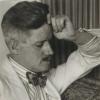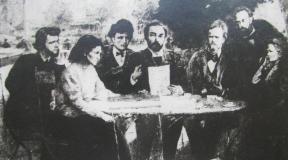Do-it-yourself powerful strobe light. How to make a strobe light for ignition with your own hands How to assemble a strobe light from LEDs
Many people know how important it is for the smooth operation of the engine to correctly set the ignition timing and ignition timing regulators. Incorrect setting of the initial ignition timing by only 2-3 degrees, as well as various malfunctions of the timing regulators will lead to loss of engine power, overheating, increased fuel consumption and, most sadly, a reduction in the life of the car engine.
But checking and adjusting the advance angle is a very big problem, which is not always accessible even to an experienced mechanic. A DIY strobe will help solve this problem. With their help, any car enthusiast can check and set the ignition timing within 15 minutes, as well as check the performance of the centrifugal and vacuum timing regulators.

The basis of the strobe circuit is timer devices assembled on KR1006VI1 microcircuits, which have more stable timing characteristics, since the pulse duration and pause between pulses do not depend on the voltage of the power source.
The device is connected to the high-voltage wire of the first cylinder of a gasoline engine using an alligator clip. In the upper position of the SA1 switch slider, the device operates in tachometer mode, in the lower position - in car strobe mode.

DIY strobe circuit diagram for KR1006VI1
In the upper position of the switch SA1, timer DD1 is switched on according to a pulse generator circuit with a duration of approximately 0.5 ms and is determined mainly by the values of resistor R4 and capacitor C2. This pulse duration is optimal and was selected according to the following criteria. If the pulse duration is short, the brightness of four LEDs in daylight may not be enough to illuminate the mark at low engine pulley speeds. With longer pulse durations, the image of the mark will be unclear, “blurry” at high engine speeds.
The pulse repetition period depends on the values of resistors R5, R6 and capacitor C2, and is regulated by variable resistor R6.
In the lower position of the switch SA1, the device operates in car strobe mode. Timer DD1 in this mode is switched on according to a one-shot pulse circuit with the same duration of 0.5 ms. The one-shot device is triggered by a negative voltage drop at the input of the device, which is fed through the circuit C1, R3, SA1.2 to the input of the timer DD1. Transistor VT1 amplifies the current to the required value.
A pulse current of 250 mA through the LED is too high, so the values of resistors R11, R12 are chosen so that the pulse current through each of the LEDs HL1...HL4 at a low flash frequency does not exceed 100 mA. At a high flash frequency, the period decreases, and capacitor C6 does not have time to charge through resistor R10 to a voltage close to the voltage of the power source. Therefore, the voltage across it decreases. This leads to a decrease in the pulse current through the LEDs, which significantly increases the reliability of the device.
Diode VD1 decouples the charge and discharge circuits of capacitor C2. Resistor R3 and diode VD2 protect the timer input DD1 from high positive voltage. Timer DD1 is protected from negative voltage by resistor R3 and an internal diode. Capacitors SZ, C4 are noise suppressing. Diode VD3 protects against erroneous reversal of the power supply polarity.
Any diodes from the KD521 series can be used as diodes VD1, VD2. The VD3 diode can be replaced with any diode from the Kd212 series. The KR1006VI1 timer can be replaced with an imported analog NE555. Resistor R6 is used type SPZ-Z0a with characteristic B and a motor rotation angle of 270°. You can use a SP-I type resistor, but it has a smaller motor rotation angle - 255°.
If the radio amateur does not have a variable resistor with characteristic B at his disposal, then a variable resistor with characteristic B can be used, but in this case the scale will be reversed. If there is no variable resistor with a nominal value of 220 kOhm, you can use a variable resistor with a nominal value of 150 kOhm or 470 kOhm. In the first case, the values of resistors R4, R5 should be reduced, and the value of capacitor C2 should be increased by 1.47 times. In the second case, the values of resistors R4, R5 should be increased, and the value of capacitor C2 should be reduced by 2.14 times. The temperature and time characteristics of the device depend on the type of capacitor C2, so it is better to use capacitor C2 of type K73-17 for a voltage of 63 V. Switch SA1 - any small-sized one with two positions and two directions, for example, type P2T-1 -1 V. Capacitors C5, C6 - type K50-35, but imported ones are better, they have smaller dimensions and leakage current. Capacitor C1 is type KT-2, or another type, but it must withstand a voltage of at least 500 V. Capacitors SZ, C4 are type KMZ...KM6. Variable resistor R1 - small-sized type SP4-1. Transistor VT1 must have a current gain of less than 50 and a maximum collector current of at least 0.4 A.
As VT1, you can use a field-effect transistor KP505A (B, C). In this case, resistors R8, R9 must be excluded, and the gate of the transistor must be connected to pin 3 of the DD1 microcircuit. The wire from the clamp to the device must be shielded. Its length should not be chosen more than 35...40 cm. The shielding braid is connected to the common wire at the output of the device.
When a radio amateur develops a strobe light circuit board design with his own hands (for example, in), it should be taken into account that the input circuits of the DD1 timer should be as short as possible, since a car gasoline engine is a powerful source of interference.
Setting up a strobe light yourself
Set switch SA1 to the top position according to the diagram and calibrate the scale of variable resistor R6 using a frequency meter or, worse, an oscilloscope. As a last resort, if you do not have a frequency meter and an oscilloscope, you can calibrate the device using a digital multimeter with a capacitance meter. Pulse duration t, = 0.7 R4C2. Pause duration t2 = 0.7 (R5 + R6) C2. For ease of use, the device should be calibrated in min-1. This completes the setup of the device. There is no need to equalize currents through LEDs HL1, HL2 and HL3, HL4.
Using the device is not difficult. To check the operation of the vacuum and centrifugal ignition timing regulators of a gasoline engine, set the SA1 switch slider to the lower position. Attach the sensor to the high-voltage wire of the first cylinder of the engine, supply power to the device. Start the engine and aim the flashing light at the timing marks. If the marks are difficult to see due to dirt or metal oxides, they should be cleaned and highlighted with white paint or chalk. Set the resistance of resistor R1 so that the device stably triggers a spark only when the sensor is connected to the high voltage wire of the first cylinder of a gasoline engine.
To measure the rotation speed of the engine rotor (crankshaft), move switch SA1 to the upper position, apply power to the device and direct a beam of flashing light to the pulley of a running engine with a pre-marked mark. By rotating the motor of the variable resistor R6, make sure that the pulley with the mark appears motionless. The mark should be visible only in one place on the engine pulley. If there are two marks on the pulley, this means that the flash frequency is twice the speed of the engine shaft.
The device was tested in operation for 48 hours in tachometer mode at the minimum and maximum flash frequencies of LEDs HL1 ... HL4 from a voltage source of 16 V and showed high operational reliability.
As a relay, you can use the domestic analogue of RES-10 at 12 volts.
The circuit operates according to the following algorithm: at the moment the supply voltage is supplied from the battery, capacitor C1 begins to charge through resistor R3. Having reached the desired value, this voltage goes to the base of the transistor, which opens. After this, relay a is triggered, its contact closes and prepares the thyristor for opening. As soon as the control pulse arrives at the control electrode of the thyristor through the voltage divider on resistors R1, R2, the thyristor opens, and the capacitor begins to discharge through the LEDs. There is a short bright flash.
Then the transistor closes, opens its contact and the relay, but with a slight delay, thereby increasing the LED burning time by a fraction of a second. The circuit goes to its initial state, waiting for the next control pulse.
Thanks to this simple circuit design, the flickering of the strobe LEDs becomes brighter and the mark on the flywheel is clearly visible.

Do-it-yourself strobe, simple relay circuit
By selecting the capacitor capacity, you can vary the duration of LED burning. The higher the capacitance value, the stronger the flash, but also the longer the tag trail. With a lower capacitance value, the sharpness of the mark increases, but the brightness decreases.

Elements of the strobe circuit can be placed in the body of the LED flashlight without much difficulty. A small hole is made on the back of the flashlight and power wires at least half a meter long are passed through, at the ends of which crocodiles are soldered for ease of use. A hole is also made in the side of the housing for the shielded wire of contact X1. At the end, the screen braid is tightly wrapped with electrical tape, and a 10 cm long copper wire is soldered to the central core, which is a strobe sensor. When connected, this wire must be wound in 3-4 turns onto the high-voltage wire of the first cylinder over the insulation. Be sure to do the winding as close to the spark plug as possible to avoid interference from neighboring wires.
The basis of the strobe circuit is the 155AG1 single-vibrator integrated circuit, which is triggered by pulses of negative polarity. Therefore, to form them, the control signal from the car breaker is supplied to the base of the bipolar transistor VT1, which forms them. Resistors R1, R2, R3 and zener diode VD2 are designed to limit the amplitude of the input signal coming from the ignition switch.

DIY strobe light with LEDs
Capacitance C4 and resistor R6 regulate the required duration of the pulses generated by the one-shot device. With the values specified as in the diagram, the duration of these pulses will be 1.5-2 ms.
The process of adjusting the initial ignition timing is greatly simplified when using special devices. Their work is based on the stroboscopic effect. The meaning of this physical phenomenon is as follows: if you illuminate a moving object with a short flash of light, a visual illusion will arise that it remains in the same position in which this flash caught it.
Making your own LED strobe is very simple. There are diagrams of simple devices that even an inexperienced radio amateur can repeat.
LED strobe on timer NE555
The main component in this strobe circuit is the NE 555 integrated timer. This is a common chip often used in electronic homemade products.
A ready-made assembly of six LEDs from a Chinese lantern is used as a light emitter.
Strobe circuit on NE555 timer
Potentiometer P1 sets the pause time between pulses, which are supplied to VT1. Opening at the moment the signal is given, the field-effect transistor “lights” the strobe.
It should be taken into account that at the moment of the flash, the current passing through the emitter exceeds two amperes. This circumstance forces the use of a limiting resistor with a dissipation power of at least 2W. There is no reason to worry about LED failure. Ultra-short operating times in such modes will not cause damage to semiconductors.
Instead of the transistor indicated in the diagram, you can use its closest analogues: IRFZ44, IRF3205, KP812B1 and others.
The requirements for the VD1 diode are high performance. 1N4148 is being successfully replaced by the domestic version KD522. Any Schottke diodes will also work well.
The capacitance of capacitors can be increased by one order of magnitude. This will not affect the performance of the circuit in any way.
This is what the assembled device looks like, with three high-power LEDs.
 Stroboscope assembly
Stroboscope assembly A small number of parts allows you to make a strobe from LEDs using the hinged method or using special mounting panels. If no errors are made during the soldering process, the circuit will work immediately, without additional adjustment.
Another variation of assembling a do-it-yourself car strobe light on LEDs is based on the TL494 PWM driver. The cost of the microcircuit is in the range of 10 - 20 rubles per piece, so it cannot be called scarce. In addition, you can remove the required component from an old ATX power supply from a personal computer.
 LED strobe circuit on a TL494 PWM controller
LED strobe circuit on a TL494 PWM controller As in the previous case, the emitter is controlled by a MOSFET transistor. Here it can be of any type that meets two requirements:
- Rated current – from 2A;
- internal structure is N-type.
Examples of suitable field workers: AP15N03GH or IRLZ44NS.
Trimmer resistor VR1 sets the duty cycle (duration of flashes), and VR2 sets their frequency. It is more convenient to use potentiometers with a linear dependence, so the setting process is much easier.
The light source in this strobe circuit is one powerful LED. To connect a 12-volt LED strip, resistor R6 must be removed by installing a jumper instead.
The remaining elements of the LED strobe circuit can be anything with the specified ratings.
Device circuit board
The size of the structure can be minimized using SMD components. Some novice radio amateurs try to avoid using them, believing that installing small parts is too labor-intensive. And in vain! A little practice will help you cope with this task without difficulty. But the result will be an excellent reward for your patience.
A sample implementation of a printed circuit board for an LED strobe is shown in the figure.
 Sample printed circuit board for a strobe light
Sample printed circuit board for a strobe light
A two-way wiring method is used here. Large radio elements are installed on top: a microcircuit, terminal blocks and electrolytic capacitors, on the bottom resistors and capacitors of size 1206, LEDs of size 0805, a MOSFET transistor in a DPAK package. Regulating resistors have been replaced with tuning resistors. This was done to reduce the size of the structure.
The appearance of the board of the finished device from both angles is presented below. To transfer a pattern with tracks onto foil-textolite, the LUT method was used. Etching was carried out in an aqueous solution of ferric chloride.

If you want to repeat the LED strobe circuit with your own hands, you can use the project for the Sprint Layot tracer, changing it if necessary to suit your own needs. .
The consideration in the article of stroboscope circuits is distinguished by their simplicity and low cost of electronic components. The total cost of materials will cost tens of times less if you purchase a ready-made LED strobe. In addition, using a homemade device is much more pleasant, and the experience gained in the process of work is irreplaceable and priceless.
Even as a child, I assembled a strobe light using an IFK-120 pulsed gas-discharge lamp.
When the scheme started working, the joy was immeasurable... 10 years have passed since then, and so I decided, so to speak, to remember the past, but “in a modern style.” In modern style - it's LED. The advantages of LEDs are obvious - they are not afraid of vibration, durable, safe, etc. With continuous illumination, the service life of the LED is on average 50 thousand hours. Well, in the short-term glow mode, the service life increases many times over, because LEDs have another undeniable advantage - they are absolutely not afraid of being turned on and off.
The strobe light circuit is as simple as three rubles and is assembled using parts from the trash heap.

To assemble a strobe circuit, just find a non-working ATX power supply from your computer. In most of these power supplies, the “heart” is the TL494 chip, a widely used PWM driver. It is also worth noting that this chip is sold in almost any radio store for next to nothing, and the device is assembled on it. Resistors and capacitors can be taken from the same power supply. I used the field-effect transistor from a non-working motherboard, there are about 10 of them, any N-channel powerful field-effect transistor is suitable, for example, AP15N03GH or IRLZ44NS. Trimmer resistors adjust the flash frequency (VR2) and flash duration (VR1). LED VD1 (green) indicates the presence of power, LED VD2 (red) shows the voltage at the output of the circuit. Resistor R6 limits the current through a powerful LED, the resistance of this resistor is selected experimentally until the optimal current through the LED is achieved, and this resistor must also have a power of 2...5 watts. The power supply to the circuit can be anything in the range from 10 to 20 volts, but when the supply voltage changes, it is necessary to change the resistance of resistor R6, which limits the current through a powerful LED. In addition to LEDs, you can connect LED strips to the circuit. When connecting LED strips designed to be powered directly from 12 volts to a strobe, you need to install a jumper instead of resistor R6, since the strips already contain limiting resistors, and you also need to power the circuit strictly from 12 volts. If there is not enough range for adjusting the flash frequency, then you need to change the value of capacitor C1. Increasing the capacitance reduces the frequency (flashes occur less frequently), decreasing the capacitance increases the frequency (flashes occur more frequently). When assembled correctly, the circuit starts working immediately. To check the circuit, you need to set the trimming resistors VR1 and VR2 to the middle position and apply power to the circuit. I powered the circuit with 12 volts.
On the printed circuit board, almost all SMD resistors and capacitors of size 1206, LEDs of size 0805, a field-effect transistor in the DPAK package, trimming resistors VR1 and VR2 must be multi-turn. Capacitors C2, C4 are ceramic. Capacitors C1, C3 - any type.
Since the LED must operate in strobe mode (give short flashes), the duration of the flashes should be set to almost minimum (with trimming resistor VR1). The tuning resistor VR2 adjusts the flash frequency “to taste”.
I used an OSRAM OSTAR SMT RTDUW S2W LED installed on a processor heatsink from an old computer.

This LED contains 4 crystals, 700 mA (2.5 W) each. All crystals are of different colors: Red, Green, Blue, White.

If you use all 4 crystals at once (connect them in series), you will get white light. That's exactly what I did. The resistance of resistor R6 with a power supply of 12 volts turned out to be 5 Ohms. Resistor R6 limits the current through the LED, since the LED must be powered with a stable current. Instead of current-limiting resistor R6, you can use the LM317 microcircuit, connected according to a current stabilization circuit (chip + external resistor). In strobe mode, the LM317 can be operated without a heatsink, since the LED is not lit most of the time. When using the device in beacon mode, you must install LM317 on the heatsink.
Here are a few examples of connecting various LEDs to the strobe board:

Photo of the strobe board:


View from the paths. The board didn't turn out very well, but it'll do:

Arrangement of components on the board:

Attached is a video of the strobe in action.
List of radioelements
| Designation | Type | Denomination | Quantity | Note | Shop | My notepad |
|---|---|---|---|---|---|---|
| U1 | PWM controller | TL494 | 1 | To notepad | ||
| VT1 | MOSFET transistor | AP15N03GH | 1 | IRLZ44NS | To notepad | |
| VD1 | Light-emitting diode | AL307V | 1 | To notepad | ||
| VD2 | Light-emitting diode | AL307B | 1 | To notepad | ||
| C1 | Capacitor | 2.2 µF | 1 | To notepad | ||
| C2, C4 | Capacitor | 100 nF | 2 | To notepad | ||
| C3 | Electrolytic capacitor | 100 µF | 1 | To notepad | ||
| R1 | Resistor | 9.1 kOhm | 1 | To notepad | ||
| R2 | Resistor | 100 kOhm | 1 | To notepad | ||
| R3 | Resistor | 1 kOhm | 1 | To notepad | ||
| R4, R5 | Resistor |
The correct operation of a car engine depends on how the ignition is set. This is due to the fact that the combustible mixture entering the combustion chamber must be completely ignited. To install the ignition, a strobe light is used, which you can make yourself or purchase at a specialized store. We will discuss below how easy it is to make a strobe light for installing the ignition with your own hands.
The purpose of the strobe, the parts that will be needed for its manufacture
The strobe light for installing the ignition is used so that the car enthusiast can adjust the correct and timely supply of electric current, which forms a spark. It serves to ignite the incendiary mixture in the combustion chamber of the cylinders of gasoline power units.
The correct operation of the motor and its power depend on the timeliness of its supply. Therefore, correctly set ignition is necessary for the power unit to work well.
In specialized stores, this device costs from 1,000 to 7,000 rubles. Therefore, in order to save money, it is better to make a homemade strobe light to install the ignition with your own hands. To assemble it (I did it myself), you will need to spend up to 500 rubles.
In general, a strobe light is a simple circuit and design. It is based on the principle of the effect of a spark on the ice of a light bulb, which can be taken from any flashlight. Thus, it is easy to set the ignition angle, which will ideally meet the requirements for timely and complete ignition of the fuel mixture.

Let's look at the list of parts that you will need to easily make your own strobe light:
- transistor marked KT 315;
- thyristor, which is marked KU 112 A;
- copper wires;
- flashlight with diode bulbs (there should be at least 6 of them, more possible);
- timer, used for some homemade strobes;
- low-frequency diode marked V 2;
- resistors, with a power of 0.125 W;
- a relay that has the index RWH/SH-112D;
- 1 meter long cord to power the device;
- base for collecting the microcircuit, made of insulating special material;
- special terminals (clamps).
Here are the components you will need to install the strobe light yourself. They can be purchased in special stores or at radio markets.
The circuit of the simplest strobe looks like this:

It is important to remember that to make this device it is best to take the body of a simple diode flashlight, or from a flashlight. All the parts will fit there, including the microcircuit on which the parts will be located.
Strobe assembly
The assembly process takes place at home using a soldering iron, using the following algorithm (the body of the flashlight is taken as the basis):
- drilling a hole on the back wall of the flashlight body, this is necessary in order to route the power cord;
- soldered to the ends of the cord special terminals, the main thing is not to confuse the polarity (they are taken in different colors);
- sensor placement on the right or left side of the body;
- drilling a hole, it is done at the location of the sensor, a cord is inserted into it (a cord is laid), which is connected to contact X 1, indicated in the diagram;
- assembling a microcircuit, this is done according to the above scheme, using a soldering iron (if the car enthusiast is not good at assembling such circuits, then he needs to contact a specialist in this field);
- soldering copper wire to the main core of the wire, it will serve as a special strobe sensor;
- insulation of all connections special tape.
Here's how to make a strobe light with your hands with the lowest financial costs.
It is important to remember that such a device can be used not only for setting the ignition, but also for checking spark plugs and adjusting the regulator. That's how many useful functions it can perform for a car enthusiast.
Types of homemade stroboscopes
Above is a diagram and algorithm for creating a simple strobe light. Some craftsmen also recommend making such devices based on a timer or LEDs.
Let's look at the strobe circuit, which includes a timer:

This design is more complex, so if a car enthusiast thinks that he cannot assemble it on his own, it is better to contact a specialist and purchase all the necessary parts. If there is no domestically produced timer, it can be replaced with a foreign one, which should be marked NE 555. And it is better to use diodes for such a circuit with the designation KD 521.
It is interesting to know that having made such a device with a timer, you can install a regulator on it, by switching which it will begin to work like a tachometer. At the same time, even a weak battery charge will not affect its operation.
Now let's look at a circuit that allows you to make a strobe using LEDs. It should be noted right away that they are characterized by increased reliability; it can be used even in bright daylight.

The diagram of such a strobe is as follows:

The entire circuit will be based on a microcircuit marked 155 AG 1, which can be triggered by pulses that have negative polarity. Resistances suitable for it are R 1, R 2, R 3, resistor R 6. Resistances limit the amplitude of the incoming signal, and capacitance C 4 regulates the duration of the signal coming from the motor.
Setting up the strobe
After this device is manufactured, it needs to be configured. It happens this way:
- the engine is warming up, it needs to be started, warmed up, and then switched to idle mode;
- The strobe is connected by terminals to the battery;
- a copper wire (sensor) is wound around the core of the cylinder;
- the light that will be created is directed to a special point marked on the body;
- find a fixed plane (point) on the motor flywheel;
- Rotate the body of the ignition element so that the two points coincide, and then fix it in this place.
After these manipulations, the device is ready to perform its functions. The main thing is not to violate this installation order.
You can make a strobe light for setting the ignition yourself by purchasing the necessary parts. After that, it is customized and will serve the car enthusiast no worse than those sold in stores. In addition to setting the ignition, such devices, made using a timer or LED lights, can perform other useful functions.
Read also...
- Lenten borscht - Ukrainian borscht recipe How to cook lean borscht
- Why do you dream of hairy or broken knees, sometimes with blood? Someone is kneeling in front of you dream books
- Main risk groups of the population, their classification What kind of risk group 0
- Strong spells against envy What to do if your neighbor is jealous



















